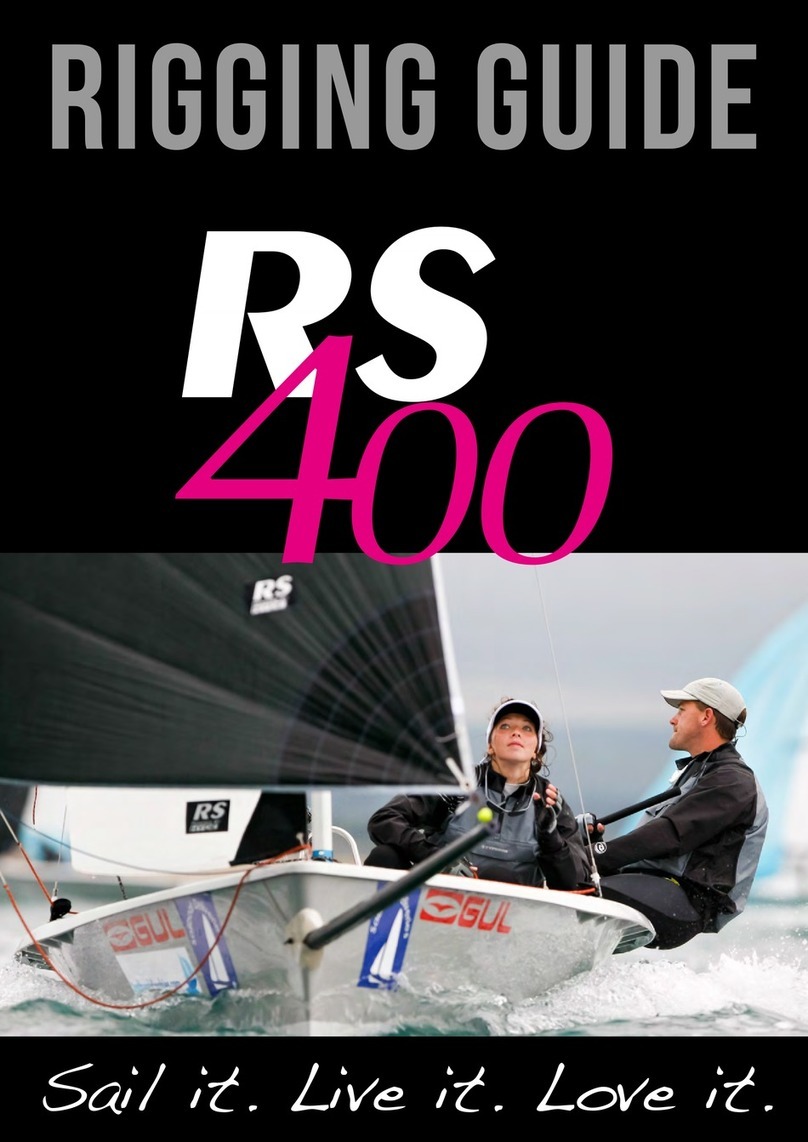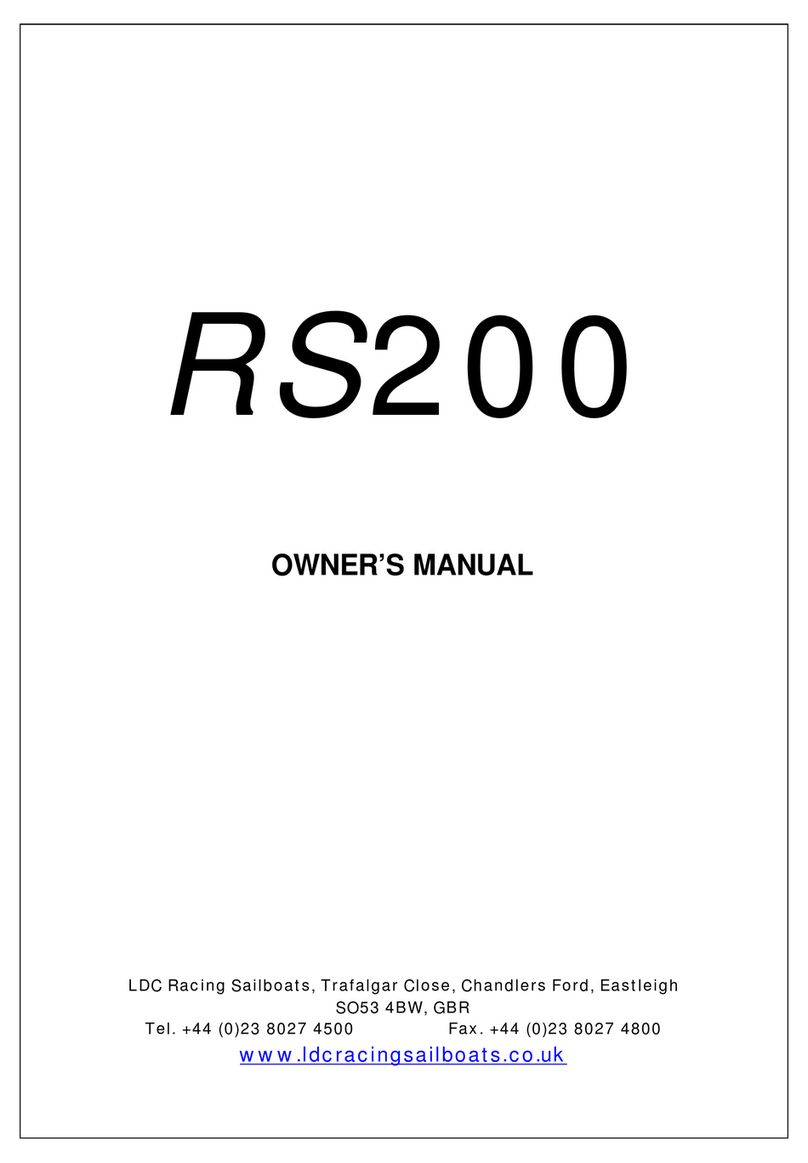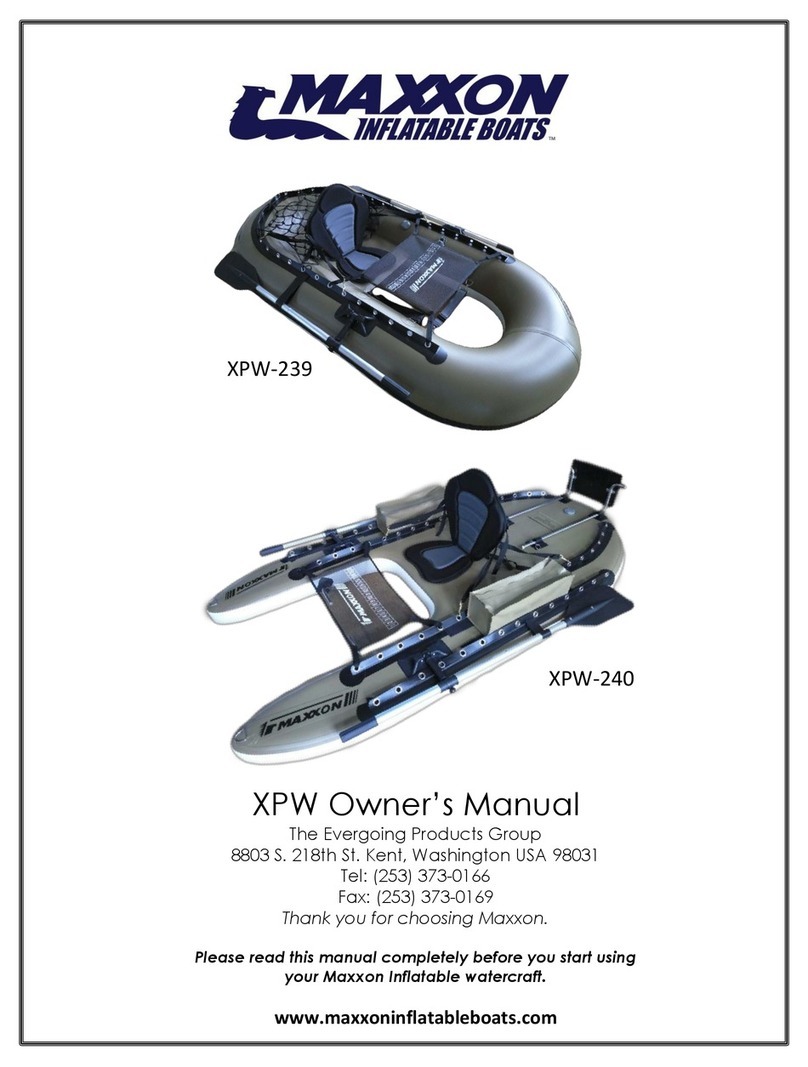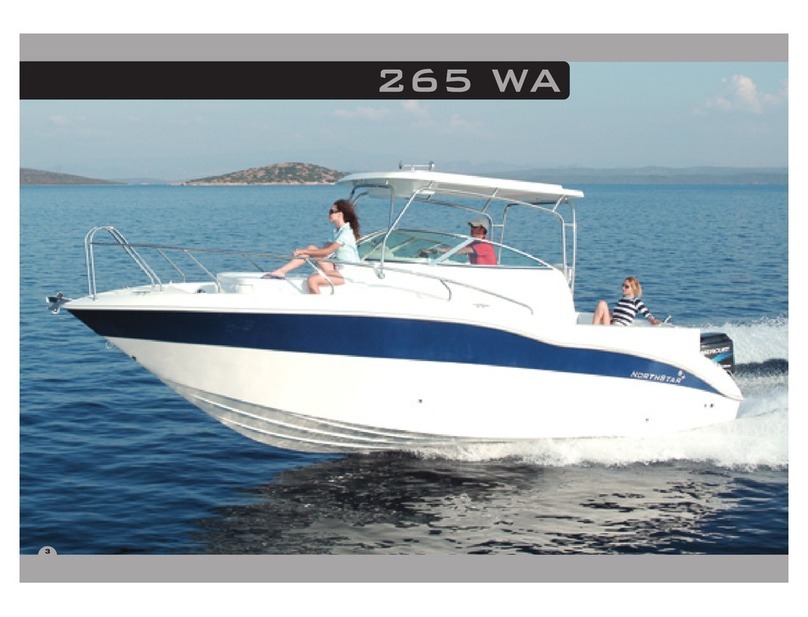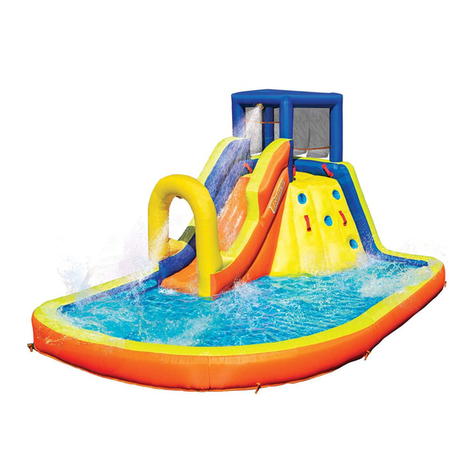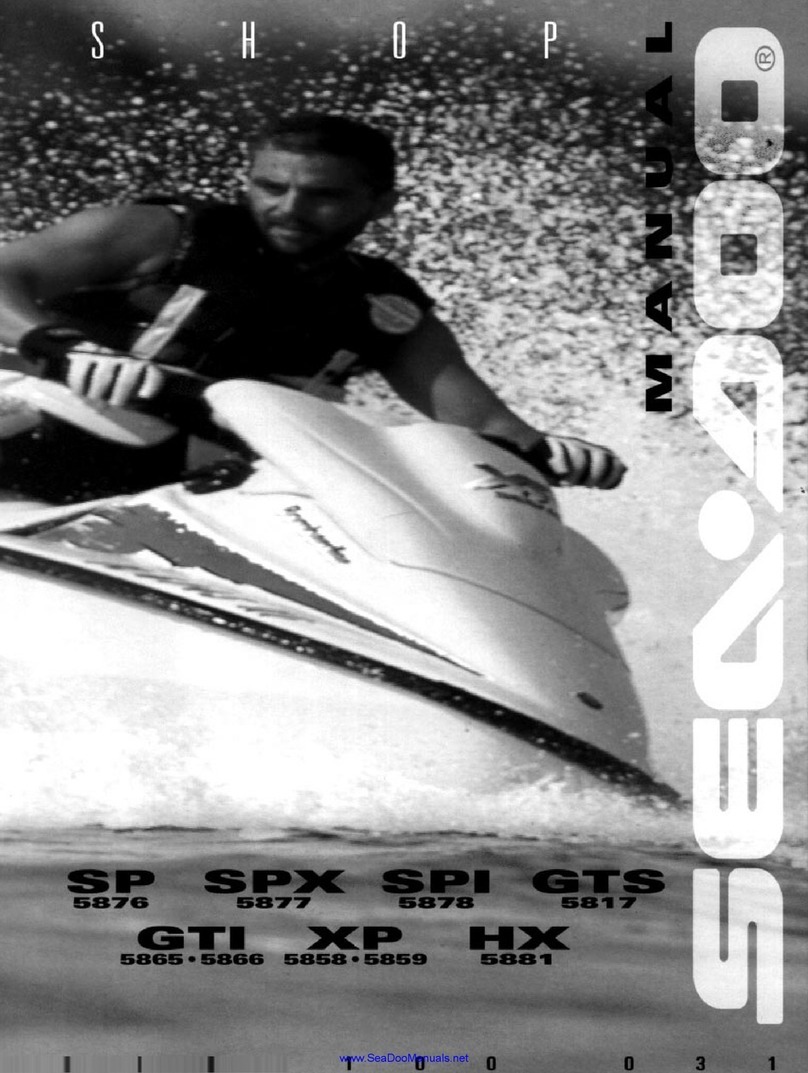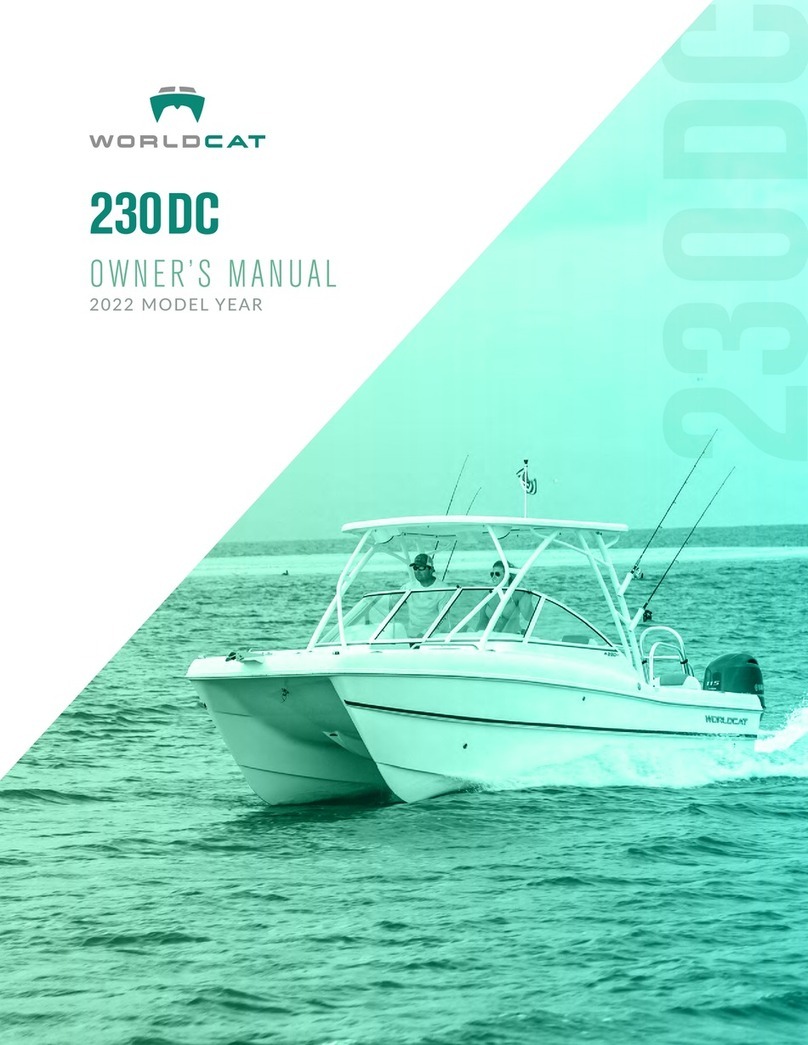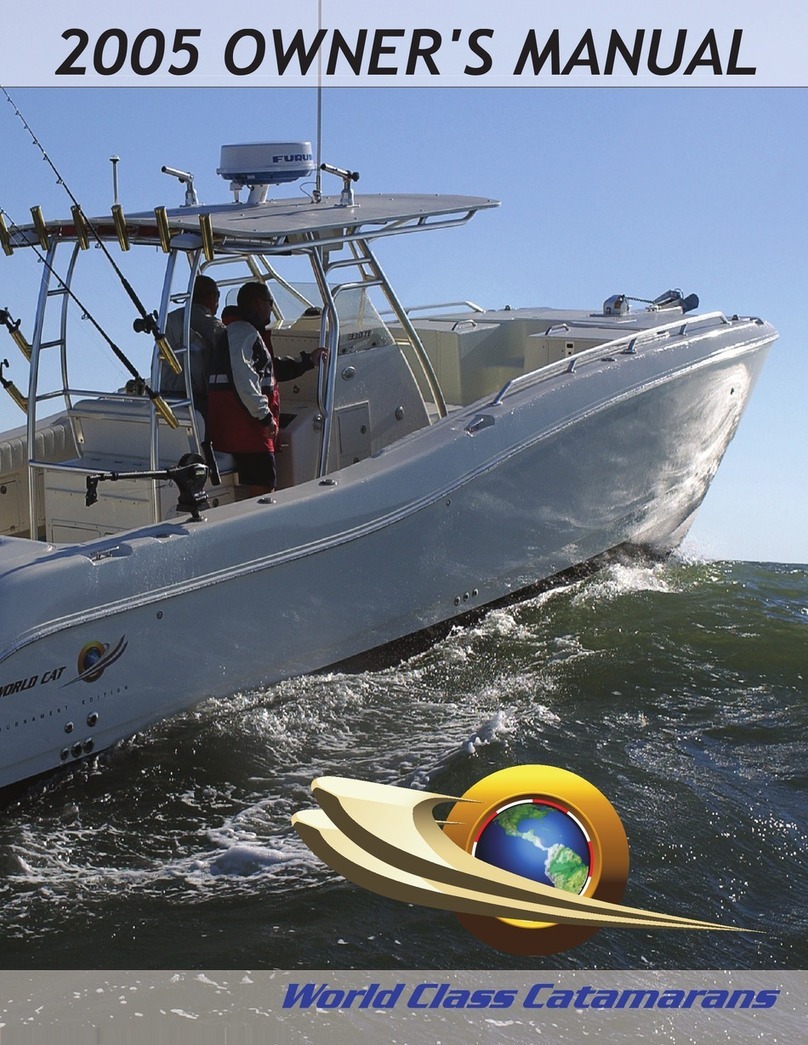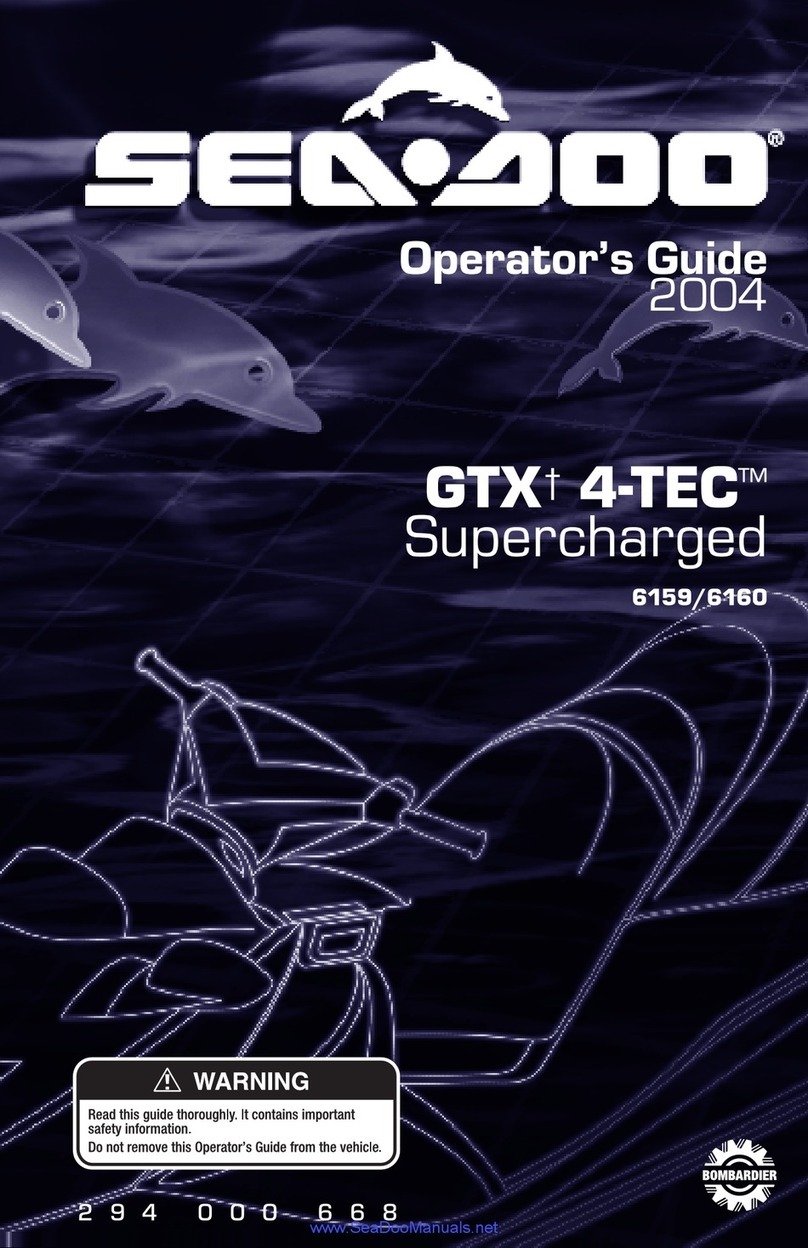LDC Racing Sailboats RS800 User manual

1
RS800
OWNER’S MANUAL
LDC Racing Sailboats, Trafalgar Close, Chandlers Ford, Eastleigh SO53
4BW, GBR
Tel. +44 (0)23 8027 4500 Fax. +44 (0)23 8027 4800
www.RSsailing.com

2
INDEX
1. INTRODUCTION
2. SPECIFICATIONS AND DRAWINGS
3. SAFETY INFORMATION
3.1 Design Category
3.2 Loading
3.3 Safety Equipment
3.4 Capsize Recovery
3.5 Air Tank
3.6 Man Overboard Prevention and Recovery
3.7 Use of an Outboard Engine
3.8 Towing, Anchoring, Mooring and Trailing
4. COMMISSIONING
4.1 Preparation
4.2 Wing Width
4.3 Mast
4.4 Boom and Vang
4.5 Hoisting Sails
4.6 Completion
5. SAILING HINTS
5.1 Introduction
5.2 Trapezing
5.3 Tacking
5.4 Gybing
5.5 Hoisting the Spinnaker
5.6 Dropping the Spinnaker
5.7 Very Light Winds
6. TUNING GUIDE
6.1 Rig Tension
6.2 Cunningham
6.3 Vang
6.4 Outhaul

3
6.5 Foils
7. MAINTENANCE
7.1 Boat Care
7.2 Foil Care
7.3 Spar Care
7.4 Sail Care
8. WARRANTY

4
1. INTRODUCTION
Congratulations on the purchase of your new RS 800 and thank you for
choosing an RS product. We are confident that you will have many hours of
great sailing and racing in this truly excellent design.
The RS800 is an exciting boat to sail and offers fantastic performance. It is a
lightweight-racing dinghy and should be treated with care. This manual has
been compiled to help you operate your RS 800 with safety and pleasure. It
contains details of the craft; the equipment supplied or fitted, its systems and
information on its safe operation and maintenance. Please read it carefully
and be sure that you understand its contents before using your RS 800.
If this is your first craft, or you are changing to a type of craft you are not
familiar with, for your own safety and comfort, please ensure that you have
adequate experience before assuming command of the craft. If you are
unsure, your dealer or national sailing federation will be able to advise you of
a local sailing school, or competent instructor.
Please keep this manual in a secure place and hand it over to the new
owner if you sell the craft.
For further information, spares and accessories, please contact your
local dealer or:
LDC Racing Sailboats
Trafalgar Close
Chandlers Ford
Eastleigh
Hants SO53 4BW
Tel. 023 8027 4500
Fax. 023 8027 4800
Email. [email protected]

5
EC DECLARATION OF CONFORMITY TO
DIRECTIVE 2003/44/CE
I declare that the craft described as:
RS800
Bearing the Hull Identification Number:
G
B
L
D
C
8
0
Conforms to EU Recreational Craft Directive 94/25/EC as amended by
Directive 2003/44/EC
Annex 1 – sections 3.2 & 3.3 and Annex 6 – Module Aa
EU Notified Body: No. 0808 (Irish Sailing Assoc.)
ISO Standards BS EN ISO 10087, 12217, 12215, 10240,
14945, 8666
Trade Marque RS Racing
Type RS 800
Design Category C
Maximum Crew 2
Maximum Load 225kg
Overall Length 4.80m
Builders Name LDC Racing Sailboats, England
Date __ / __ / __
(The date does not indicate the date of manufacture)
Signed Name: ____________________
Signature: _________________

6
2. SPECIFICATIONS AND DRAWINGS
Identification.
Your RS 800 can be identified by two numbers, one is the sail number and the
other is the Hull Identification Number.
The sail number is the number by which you register your RS 800 with
insurance companies, the class association and also when you sign on for
events. Not only is the sail number on the mainsail itself; it is also imprinted on
the transom just below the rudder gudgeon.
The Hull Identification Number, or HIN, is required by European law. The
Recreational Craft Directive stipulates that every craft sold in Europe should
meet the categories set down by it and display an individual number to show it
meets with these rules. Your RS 800 complies with the RCD to design
category C and hence as a HIN imprinted on the starboard side of the
transom.
The HIN is purely for conformity to European regulation, therefore, your RS
800 should be referred to by its sail number.
Dimensions.
Length Overall (LOA):
4.80 m
15’ 9”
Waterline Length (LWL):
Beam:
1.88 – 2.89 m
6’ 2” – 9’ 6”
Draft:
Air Draft:
Hull Displacement:
62 kg
136 lb
Sailing Displacement:
110 kg
242 lb
Upwind Sail Area:
16.5 sq m
172 sq ft
Downwind Sail Area:
37.5 sq m
397 sq ft

7
3. SAFETY INFORMATION
3.1 Design Category.
The RS 800 is a Design Category C boat. The definition of this category is:
•Design Category: C – ‘inshore’
•Description of Use: Designed for voyages in costal waters, large
bays, estuaries, lakes and rivers.
•Wind Force: Up to, and including Beaufort force 6.
•Significant Wave Height: up to, and including 2 m.
The RS 800 complies with this design category, subject to:
•The crew having suitable skill and experience.
•Satisfactory construction and maintenance of the boat and its
equipment.
Users of this boat are advised that:
•All crew should receive suitable training.
•The boat should not carry more than the maximum load.
•Any water in the hull should be kept to a minimum.
•Stability is reduced by any weight added high up.
3.2 Loading.
The maximum recommended load for the RS 800 is 250 kg and the
maximum number of crew it can carry is three.
The minimum recommended crew weight is 110 kg.

8
3.3 Safety Equipment.
It is your responsibility to ensure that all necessary safety equipment is
obtained for the type of sailing you are participating in and it is readily
accessible on board while the boat is in operation.
3.4 Capsize Recovery.
The capsize is an inevitable part of dinghy sailing and the RS 800 is no
exception. The RS 800 is a racing dinghy and there is a high likelihood that
you will capsize if you sail it to its limit. You should practice capsize recovery
when you first sail the boat, ideally in an area where there is some kind of
safety patrol to assist you, should you get into difficulty.
Recovery technique.
Should you capsize your RS 800:
•If the asymmetric spinnaker was up, it should be lowered into the chute
by a member of the crew.
•The mainsheet should be uncleated and made sure that it will run freely
when the boat is righted.
•The vang should be eased to de-power the top of the mainsail.
•The RYA recommends that dinghy sailors involved in a capsize should
always consider going straight to the centreboard or dagger board to
prevent inversion and allow time and opportunity for any entrapment to
be resolved by those involved or by patrol boats. In the 700 this may be
only really relevant if you have another person on board, but should be
considered.
Warning: Entanglement in trapeze wires or associated elastic cordage has
featured in several accidents, you should ensure that before you sail you
have the appropriate training and equipment.

9
If the boat inverts, it should be pulled onto its side so that the rig is horizontal
to the water. This can be done by standing on the underside of the wing and
pulling on the daggerboard. It sometimes helps to pull it up with the aid of the
wind blowing over the deck and rig.
After that, there are two basic situations to recover from:
•When the rig is lying in the water, pointing downwind.
•When the rig is lying in the water, pointing upwind.
Both of the following methods will take some practice to enable you to right
your RS 800 quickly and effectively, but they are proven methods to enable
you to continue sailing after a capsize.
Rig pointing downwind.
You should both be on the daggerboard, with the asymmetric spinnaker
dropped, with the mainsheet and vang uncleated.
Using the asymmetric spinnaker sheet for extra leverage, pull the boat upright.
As the boat gets to about 45 degrees, one of you should climb in, either
between the wing and deck or over the wing (depending on your wing
settings).
The RS 800 is a relatively stable platform but you should endeavour to get
hold of the tiller and gain control as soon as possible. Once you are in control,
you can then sort yourself out, tidy the boat and get sailing again.
Rig pointing upwind.
This is quite often the position the boat ends up in, especially if you have
spent time in the water getting the asymmetric spinnaker down, or recovering
from the inverted position.

10
Both of you should be on the daggerboard, with the asymmetric spinnaker
dropped, with the mainsheet and vang uncleated.
As you start to right the boat, the wind will blow under the mainsail and help
you right it. Depending on the wind strength will depend on how fast the boat
rights, the stronger the wind the faster you will have to move! As the mast tip
leaves the water, one of you should climb into the boat, walk across the boat
to the new windward side to prevent it capsizing over again.
Should the boat capsize again, simply climb over on to the daggerboard and
follow the procedure for the rig pointing downwind.
3.5 Air Tank.
The RS 800 is equipped with a sealed buoyancy compartment just in case of
capsize or swamping. The buoyancy compartment is formed by the hull and
deck mouldings and consequently the following points should be noted:
•Do not puncture the buoyancy compartment.
•Should the buoyancy compartment become punctured, do not use
the boat until the compartment is properly repaired. If in any
doubt, contact RS Racing for repair details.
•It is against class rules to add any fittings; you may have to
replace fittings from time to time. Ensure that all fastenings are
resealed properly using an appropriate sealant. If in any doubt,
contact RS Racing for details.

11
3.6 Man Overboard Prevention and Recovery.
Working deck.
The working deck of the RS 800, which is intended to be occupied only when
the boat is afloat, is the areas covered with a none slip coating. These areas
are:
•The entire cockpit floor, including kick-blocks, from the aft end up to the
mast foot.
•The top surface and outside edge of the side deck from the aft end to
the front wing tube.
•Additionally, the forward part of the cockpit covered by non-slip coating
for 500mm in front of the mast.
•Whilst trapezing, the outside edge and top of the wing bar, where the
non-slip is applied.
Crew overboard recovery.
The RS 800 is designed to be sailed with two persons. However, it can
accommodate three members of crew. When sailing it is recommended that
you ensure adequate safety cover is in attendance before launching should
you or your crew get into trouble.
Should one of you fall overboard, be it helm or crew, you should try to gain
control of the boat as soon as possible. It may be that the boat has capsized
soon after, in which the missing crewmember should endeavour to return to
the boat to aid in it’s righting.
To recover a crew member from the water:
•The helm should bring the boat just downwind of the person in the
water.

12
•The helm should balance the boat, using a combination of body weight
movement and sail pressure.
•The crew should board the boat via the windward gunwale using a
combination of the following handholds: the windward shroud/lower
shroud, the trapeze wire, kick blocks in the bottom of the boat and the
wing bars.
3.7 Use of an Outboard Engine.
The RS 800 is not designed or equipped for use with an outboard engine
and is not capable of modification to be safely used with an outboard
engine.

13
3.8 Towing, Anchoring, Mooring and Trailing.
Towing.
Should it become necessary to tow the RS 800, you should follow the
procedure below:
•Secure the towing line around the base of the mast. If the mast has
failed, secure the line around the inboard end of both forward wing
tubes.
•Fully raise or remove the daggerboard.
•Stay at the tiller. In the event of rudder loss, sit well aft.
Anchoring.
The RS 800 is not designed or equipped for anchoring and this should not
normally be attempted. You should remain in control of the boat at all times.
If there is no alternative to anchoring, the anchor line should be secured round
the base of the mast (or wing tubes if mast has failed) and you should remain
in the boat at all times. If the boat must be abandoned when anchored, it is
best left in the capsized position with the rig pointing downwind.
Mooring.
The RS 800 is not designed or equipped for mooring and this should not be
attempted. You should remain in control of the boat at all times when afloat.
Trailing.
When trailing your RS 800 you should only use an approved trolley and road
base. Tying down the boat to its trailer is important because too much or too
little tension could result in damage. Follow the instructions below for safe
trailing:

14
•Ensure the boat is located correctly on the trolley, with the gunwale
supports up under the gunwales and the bow located in the bow
snubber of the trolley.
•Ensure the trolley is properly located on the road base and the
retaining pin is fitted.
•Tie the boat down to the trailer at the bow and across the middle. You
only need to apply sufficient tension to hold the boat in contact with the
trolley supports. Use padding material where any straps touch the
deck.
It is always a good idea to tie the boat down when it is left in the dinghy
compound to prevent any damage to you boat, or any other, in the event of
strong winds.

15
4. COMMISSIONING
4.1 Preparation.
Your RS 800 comes complete with all the components necessary to take the
boat sailing. In order to commission it, you will need the following tools:
•Pliers or a shackle key.
•PVC (electricians) tape.
•Dry lubricant spray (McLube or similar).
•Rig tension gauge.
You may require other tools later, should you wish to make any settings or
tuning adjustments to the boat and rig.
DO NOT use a knife or other sharp object to cut through packaging
containing parts – you may damage the contents.
Whilst your RS 800 has been carefully prepared, it is important that new
owners should check shackles, knots and mast step bolts are tight. This is
especially important when the boat is new, as travelling can loosen seemingly
tight fittings and knots. It is also important to regularly check such items prior
to sailing.
4.2 Wing Width.
The width of the wings is determined by a combination of your weight and
height. The position of your wings can be calculated using table 4.1 for RS
800s or table 4.2 and 4.3 for twin trapeze.
To adjust the wing width:
•Slide the wings out to the correct hole setting.
•Put the wing pins through the holes in the transverse wing bars and
loop the elastic retainer over the end of the pins.

16
RS800 single wire rack setting and weight tables
Crew weight (kg's)
weight 55 57.1 59.1 61.1 63.1 65.1 67.1 69.1 71.1 73.1 75.1 77.1 79.1 81.1 83.1 85.1 87.1 89.1
range 57 59 61 63 65 67 69 71 73 75 77 79 81 83 85 87 89 91
55.0999999887766554433
57.0555555554443332221
57.1999999877665544332
59.0555555544433322211
59.1999998877665544332
H
61.0555555444333222111
e
61.1999988776655443322
l
63.0555554443332221110
m
63.1999988766554443322
65.0555544433322211100
w
65.1999887766554433222
e
67.0555444333222111000
I
67.1998877665544333222
g
69.0554443332221110000
h
69.1998876655544332222
t
71.0544433322211100000
71.1988776655443322222
k
73.0444333222111000000
g
73.1887766554443322222
75.0443332221110000000
75.1887766554433222222
77.0433322211100000000
77.1877665544333222222
79.0333222111000000000
79.1776655444332222222
81.0332221110000000000
81.1776655443332222222
83.0322211100000000000
83.1766554443322222222
85.0222111000000000000
85.1665554433222222222
87.0221110000000000000
87.1665544333222222222
89.0211100000000000000
89.1655444332222222222
91.0111000000000000000
Table 4.1

17
RS800 Leverage Equalisation tables
CRM
106 108 110 112 114 116 118 120 122 124 126 128 130 132 134 136 138 140 142 144 146 148 150 152 154 156 158 160 162
11677777777777777776666555544443
11877777777777777666655555444433
12077777777777776666555554444333
12277777777777766665555444443333
12477777777776666655554444433332
12677777777766666555544444333322
12877777777666655555444433333222
13077777776666555554444333332222
13277777666665555544443333322222
13477776666655555444433333222221
C13677766666555544444333332222211
C13876666655555444443333322222111
W14066666555554444433333222221111
14266665555544444333332222211111
14466655555444443333322222111111
14665555554444433333222221111111
14855555544444333332222211111111
15055554444443333322222111111111
15255544444433333222221111111111
15455444444333332222221111111111
15654444443333322222211111111111
15844444333333222222111111111111
16044443333332222221111111111111
16244433333322222211111111111111
16444333333222222111111111111111
16643333332222221111111111111111
16833333322222211111111111111111
17033333222222111111111111111111
Table 4.2
To calculate CRM - lie on plank and read off weight - multiply by 2 and add helm and crew together.
Helms and crews are to be weighed dry - shorts/jeans and t-shirt. Wallets, belts, shoes etc removed.
CCW and CRM are to be rounded up or down to nearest even no. for rack position or nearest whole no. for lead requirement.
CRM = Combined Righting Moments
CCW = Combined Crew Weights

18

19
Weight divisions
(Combined body
weight)
>= 151kg
no lead
145-150kg
3kg
1 lump
139-144kg
6kg
2 lumps
133-138kg
9kg
3 lumps
127-132kg
12kg
4 lumps
<= 126kg
15kg
5 lumps
Table 4.3
RS 800s Trampolines.
If you intend to sail the RS800s you will need to fit the trampolines and
toestraps. As this is a single trapeze option you will either need to remove the
helms trapeze adjusters from the ends of the trapeze wires and tape the wires
to the mast.
•Ensure you have the correct trampoline for the side you are fitting. The
small cut-out for the control lines is at the front.
•Place the outboard side of the trampoline over the top of the wing bar
and secure by zipping the panels together. The zip is on the underside.
•Shackle the small loop of webbing around the control lines and cover
with the Velcro patch to secure it in place.
•Using the 4mm rope supplied, tie the inboard side of the trampoline
down to the offset clips on the side tank of the cockpit. Reasonable
tension is required to prevent the trampoline form sagging while the
helm is sitting on it.
•Tie the aft toestraps to the eyelet at the back of the boat (between the
wing bars) and forward to the eyelets on the kick blocks. Adjust the
length of these to find a comfortable hiking position.
•Finally, tie the elastic through the forward eyelet on the trampoline,
under both toestraps, and tie off on the opposite side. Tie the second
piece of elastic to the aft ends of the toe straps and loop it over the
rudder gudgeon.

20
4.3 Mast.
Rigging the mast.
Your RS 800 mast will come almost ready to step with:
•The main halyard threaded.
•The spreader deflection set.
•Shrouds, forestay and trapeze wires all fitted.
Therefore, all that is required is to check that the crews trapeze wire is lead
down the mast between the main shrouds and cap shrouds above the lower
spreaders. The helms trapeze wire should be lead down the mast aft of all the
shrouds.
As with all boats, it is a good idea to tape up the spreader bolts and split rings
along with any other sharp objects that could rip the asymmetric spinnaker.
HINT
A generous application of dry lubricant sprayed up the sail track will make
hoisting and lowering the main easier.
Stepping the mast.
Before you step the mast, check that the main, jib and asymmetric spinnaker
halyard ends are at the base of the mast, to enable the sails to be hoisted.
The RS 800 mast requires two people to step it.
•Fit the ‘boat breaker’ to the tack bar at the bow of the boat by passing
the loop of webbing around the tack bar and then passing the rest of
the ‘boat breaker’ through the loop.
IMPORTANT
The boat breaker applies enormous tension in the rig and the hull. Tension
should NOT be applied to the boat breaker when the strap is connected to
any other part of the boat, ie bowsprit or trolley handle. Application of rig
tension using the bowsprit or trolley WILL CAUSE EXCESSIVE DAMAGE to
the hull.
Table of contents
Other LDC Racing Sailboats Boat manuals
Popular Boat manuals by other brands
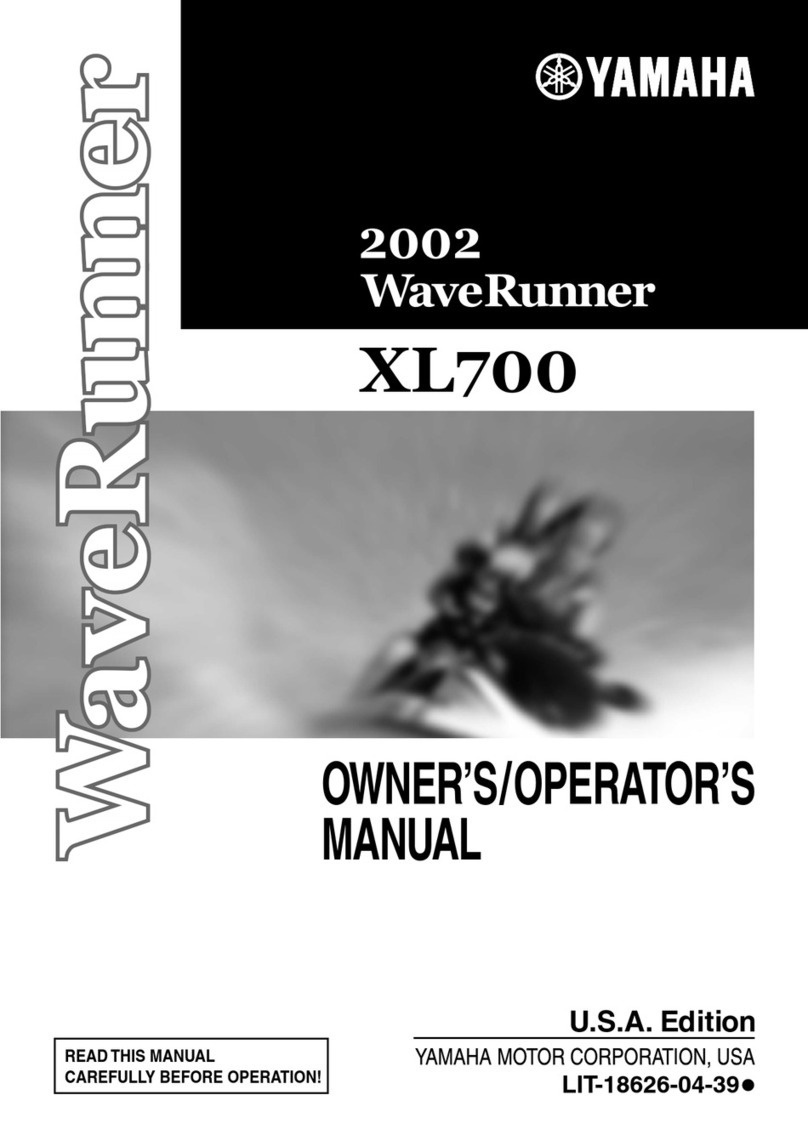
Yamaha
Yamaha XL700 WaveRunner 2001 Owner's/operator's manual
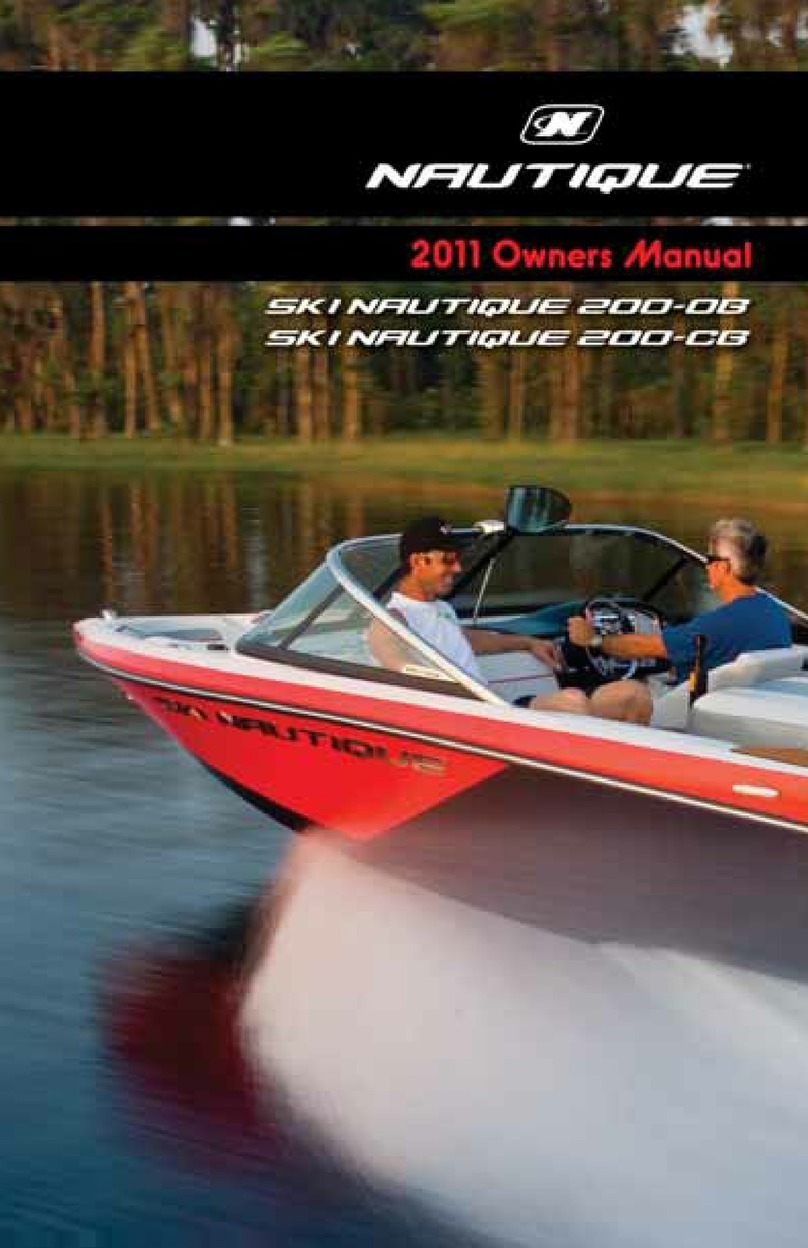
CORRECT CRAFT
CORRECT CRAFT ski nautique 200og owner's manual

BENETEAU
BENETEAU Pure Joy Too Operation manual
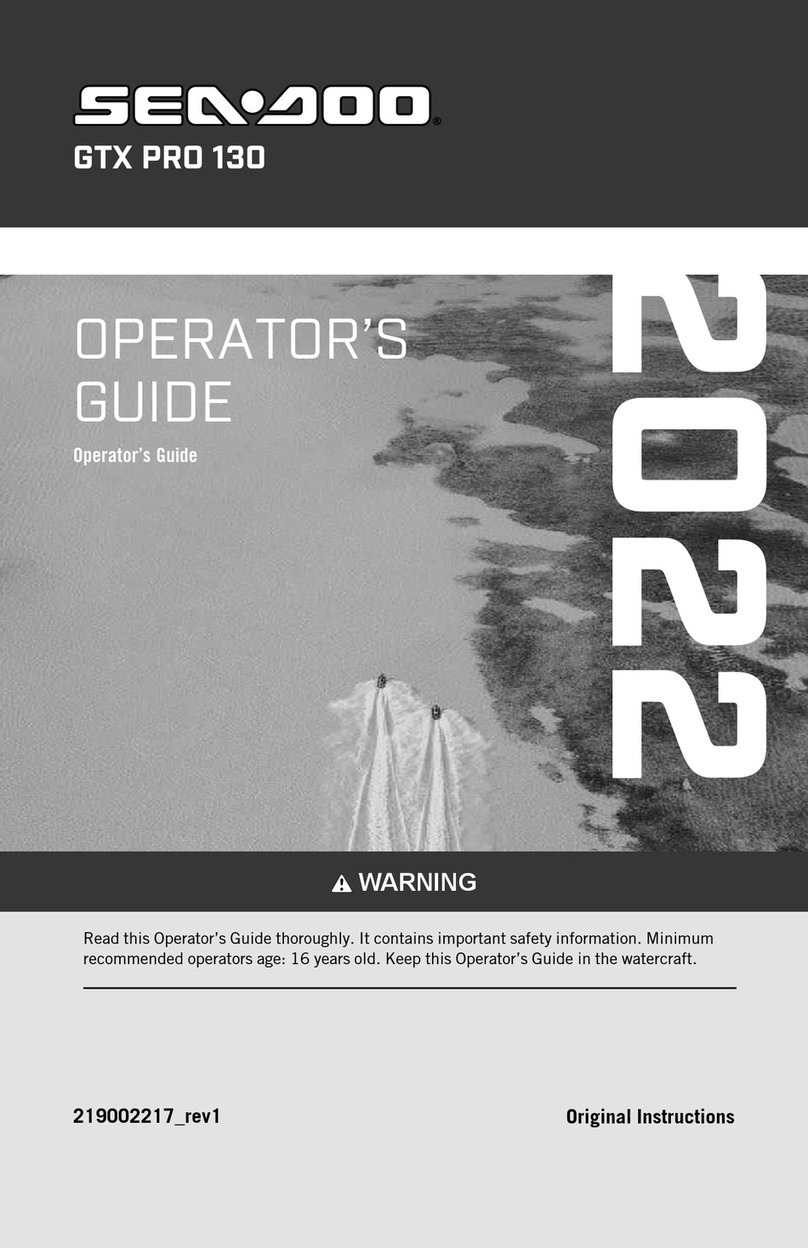
BRP
BRP Sea-Doo GTX PRO 130 Operator's guide
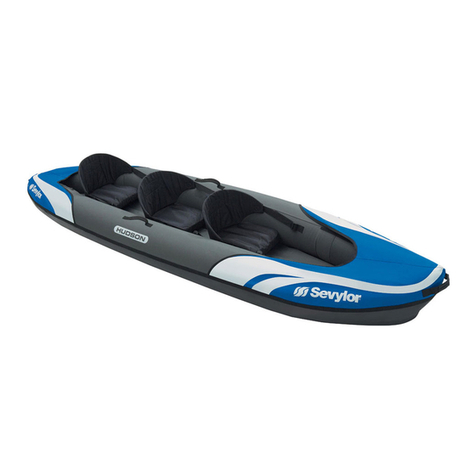
Sevylor
Sevylor HUDSON KCC360 owner's manual

Pro-Line Boats
Pro-Line Boats 17 Sport 2006 owner's manual
